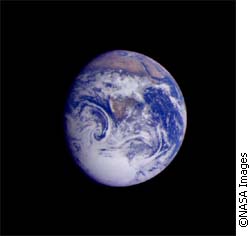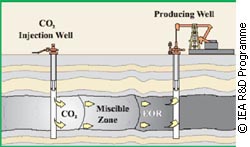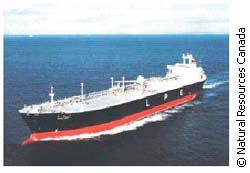| Stuff
the Earth
By Stela Susic
OTTAWA —
What goes up, must come down.
Scientists around the world are taking ownership of
the cliché and applying it to atmospheric pollution.
How? By taking gas pollutants in the air and piping
them into the earth and oceans.
 |
| The global climate has changed
in the past few decades because of the GHG effect. |
Finding answers to the great puzzle of
pollution isn’t easy, says Danae Voormeij, a researcher
at the University of Victoria. “Geological sequestration
is one way to do it,” Voormeij adds.
One of the main contributors to the problem
of air pollution is carbon dioxide (CO2).
According to Statistics Canada, CO2
accounts for 78 per cent of Canada’s greenhouse
gas (GHG) emissions.
Increased emissions of greenhouse gases
make them act as pollutants, changing global climate
beyond what is considered normal, says Voormeij. “Most
of CO2 is produced
by humans through the burning of fossil fuel. If we
produce so much of it, then it stands to reason we can
reduce it as well.”
This is where carbon sequestration comes
in, says Don White, a geology expert at Natural Resources
Canada. “It is essentially defined as the disposal
of excess carbon dioxide which will, hopefully, help
us meet our Kyoto goals."
In 2002, Canada ratified the Kyoto
Protocol, committing to cut CO2
emissions by six per cent relative to the levels in
1990. To help realize this goal, Natural Resources Canada
last year invested over $25 million to study geological
sequestration. The funding will be used over the next
five years.
| 'If we produce
so much of it, then it stands to reason we can reduce
it as well.' |
Though not a universally accepted idea,
sequestration is a step forward in improving the environmental
health of our planet, says Voormeij. “...sequestering
these emissions is a viable method ... People are not
going to change their ways; most drive large vehicles
and use large amounts of energy.”
While carbon management will help Canadians
reduce pollution, the reverse is not true, says Stefan
Bachu, a geoscience advisor for the Alberta Geological
Survey. “The general population is not likely
to support sequestration. It costs money and people
aren’t interested in electricity price hikes,”
he explains.
What is it that makes the process of carbon
management expensive?
“First of all, you have to understand
that there are two types of sequestration: indirect
and direct,” explains Carolyn Preston, an engineer
with the CANMET Energy Technology Centre.
Indirect sequestration involves removing
CO2 from the
atmosphere through forestation and agriculture practices,
she says. “This is basically using the natural
exchange of CO2
and oxygen in plants to store carbon,” adds Bachu.
Trees, or plants, act like sponges, soaking up the CO2
from the atmosphere and storing them until they decay
or encounter natural disasters such as fire.
| 'The general population
is not likely to support sequestration. It costs
money and people aren’t interested in electricity
price hikes.' |
Direct sequestration is what really costs
money, says Preston. It involves the capture and storage
of CO2 before
its release into the atmosphere; equivalent to imprisoning
the criminal prior to crime. The rainbow of approaches
used to capture carbon includes amine scrubbing and
cryogenic separation, which use high amounts of energy.
After capture, the carbon is transported, usually through
pipeline, to a storage site.
Storing CO2
Carbon dioxide storage sites are simply
called sinks, says NRC's White. Just like an ordinary
kitchen sink, geological formations suck up materials
that, through a series of pipes, are stuffed under the
surface, he explains.
Oil reservoirs have good storage potential,
says Preston. “And they’re cheaper because
the petroleum industry has the machines already in place
that can inject CO2
into the reservoir.”
 |
| Oil reservoirs are good sinks
because the infrastructure needed to store carbon
is already in place. |
The bonus with oil reservoirs, says Voormeij,
is purely commercial. “When injected into an active
oil reservoir, CO2
can improve oil recovery.” At high pressures underground,
the carbon and oil become miscible, speeding up the
migration of the oil towards the well.
The Shaquile O’Neal of geological
sinks, oceans can also store carbon dioxide. In its
liquid form, it can be transported by pipeline and dropped
on the ocean floor. “This is not very effective
because the liquid CO2
is less dense than seawater,” Voormeij says. This
means it will float to the surface and possibly circulate
into the atmosphere.
The more effective method is transporting
the gas by ship and dropping it at a depth of over 3000
metres.
 |
| Transporting carbon by ship
and dropping it to the bottom of the ocean is one
way to dispose of the gas. |
The pressure at that depth turns the CO2
into a clathrate. This ice-like mixture of carbon dioxide
and water has higher density than seawater, thus remaining
at the bottom of the ocean.
Though sinking carbon dioxide looks like
a good way to reduce greenhouse gas emissions, opinion
on the long-term issues with this practice are varied.
“My primary concern is that there
is no technology to monitor how the carbon interacts
with materials under the surface,” says Bachu.
“What if it escapes from the surface?”
There are monitoring technologies being
developed in Canada, says Preston, referring to the
$42 million Weyburn
Project in Saskatchewan designed to study the effects
of storing CO2
in oil reservoirs. The main concern should be reducing
the cost of carbon management, she adds. “If it’s
not economically feasible, it won’t survive long
enough to be replaced by new energy efficient technologies.”
Voormeij agrees, “The deciding factor...is
economics,” but “oil and gas will eventually
run out and cleaner forms of energy will take over in
the future."
|